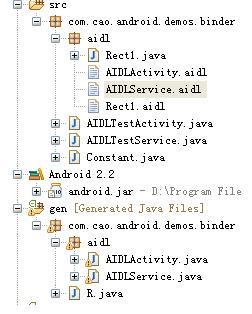Android AIDL使用特定的解释
2015-07-30 17:42
369 查看
1.什么是aidl:aidl这是 Android Interface definition language缩写,认清,这是android进程间通信接口的叙事语言描述。通过它我们可以定义进程间通信接口
icp:interprocess communication :内部进程通信
2.既然aidl能够定义并实现进程通信,那么我们怎么使用它呢?文档/android-sdk/docs/guide/developing/tools/aidl.html中对步骤作了具体描写叙述:
--1.Create your .aidl file - This file defines an interface (YourInterface.aidl) that defines the methods and fields available to a client.
创建你的aidl文件,我在后面给出了一个样例,它的aidl文件定义例如以下:写法跟java代码类似,可是这里有一点值得注意的就是它可以引用其他aidl文件里定义的接口,可是不可以引用你的java类文件里定义的接口
[java]
view plaincopy
package com.cao.android.demos.binder.aidl;
import com.cao.android.demos.binder.aidl.AIDLActivity;
interface AIDLService {
void registerTestCall(AIDLActivity cb);
void invokCallBack();
}
--2.Add the .aidl file to your makefile - (the ADT Plugin for Eclipse manages this for you). Android includes the compiler, called AIDL, in the tools/ directory.
编译你的aidl文件,这个仅仅要是在eclipse中开发,你的adt插件会像资源文件一样把aidl文件编译成java代码生成在gen目录下。不用手动去编译:编译生成AIDLService.java如我样例中代码

--3.Implement your interface methods - The AIDL compiler creates an interface in the Java programming language from your AIDL interface. This interface has an inner abstract class named Stub that inherits the interface (and implements a few additional methods
necessary for the IPC call). You must create a class that extends YourInterface.Stub and implements the methods you declared in your .aidl file.
实现你定义aidl接口中的内部抽象类Stub,public static abstract class Stub extends android.os.Binder implements com.cao.android.demos.binder.aidl.AIDLService
Stub类继承了Binder,并继承我们在aidl文件里定义的接口。我们须要实现接口方法,以下是我在样例中实现的Stub类:
[java]
view plaincopy
private final AIDLService.Stub mBinder = new AIDLService.Stub() {
@Override
public void invokCallBack() throws RemoteException {
Log("AIDLService.invokCallBack");
Rect1 rect = new Rect1();
rect.bottom=-1;
rect.left=-1;
rect.right=1;
rect.top=1;
callback.performAction(rect);
}
@Override
public void registerTestCall(AIDLActivity cb) throws RemoteException {
Log("AIDLService.registerTestCall");
callback = cb;
}
};
Stub翻译成中文是存根的意思,注意Stub对象是在被调用端进程,也就是服务端进程,至此,服务端aidl服务端得编码完毕了。
--4.Expose your interface to clients - If you're writing a service, you should extend Service and override Service.onBind(Intent) to return an instance of your class that implements your interface.
第四步告诉你怎么在client怎样调用服务端得aidl描写叙述的接口对象。doc仅仅告诉我们须要实现Service.onBind(Intent)方法,该方法会返回一个IBinder对象到client。绑定服务时不是须要一个ServiceConnection对象么。在没有了解aidl使用方法前一直不知道它是什么作用,事实上他就是用来在client绑定service时接收service返回的IBinder对象的:
[java]
view plaincopy
AIDLService mService;
private ServiceConnection mConnection = new ServiceConnection() {
public void onServiceConnected(ComponentName className, IBinder service) {
Log("connect service");
mService = AIDLService.Stub.asInterface(service);
try {
mService.registerTestCall(mCallback);
} catch (RemoteException e) {
}
}
public void onServiceDisconnected(ComponentName className) {
Log("disconnect service");
mService = null;
}
};
mService就是AIDLService对象,详细能够看我后面提供的演示样例代码,须要注意在client须要存一个服务端实现了的aidl接口描写叙述文件,可是client仅仅是使用该aidl接口,不须要实现它的Stub类,获取服务端得aidl对象后mService = AIDLService.Stub.asInterface(service);,就能够在client使用它了。对mService对象方法的调用不是在client运行。而是在服务端运行。
4.aidl中使用java类,须要实现Parcelable接口,而且在定义类同样包以下对类进行声明:
上面我定义了Rect1类
之后你就能够在aidl接口中对该类进行使用了
package com.cao.android.demos.binder.aidl;
import com.cao.android.demos.binder.aidl.Rect1;
interface AIDLActivity {
void performAction(in Rect1 rect);
}
注意in/out的说明,我这里使用了in表示输入參数。out没有试过。为什么使用in/out临时没有做深入研究。
5.aidl使用完整演示样例,为了清除说明aidl使用,这里有一个样例,样例參考了博客:
http://blog.csdn.net/saintswordsman/archive/2010/01/04/5130947.aspx
作出说明
样例实现了一个AIDLTestActivity。AIDLTestActivity通过bindservice绑定一个服务AIDLTestService,通过并获取AIDLTestActivity的一个aidl对象AIDLService。该对象提供两个方法,一个是registerTestCall注冊一个aidl对象。通过该方法,AIDLTestActivity把本身实现的一个aidl对象AIDLActivity传到AIDLTestService,在AIDLTestService通过操作AIDLActivity这个aidl远端对象代理,使AIDLTestActivity弹出一个toast。完整样例见上传的资源:http://download.csdn.net/source/3284820
icp:interprocess communication :内部进程通信
2.既然aidl能够定义并实现进程通信,那么我们怎么使用它呢?文档/android-sdk/docs/guide/developing/tools/aidl.html中对步骤作了具体描写叙述:
--1.Create your .aidl file - This file defines an interface (YourInterface.aidl) that defines the methods and fields available to a client.
创建你的aidl文件,我在后面给出了一个样例,它的aidl文件定义例如以下:写法跟java代码类似,可是这里有一点值得注意的就是它可以引用其他aidl文件里定义的接口,可是不可以引用你的java类文件里定义的接口
[java]
view plaincopy
package com.cao.android.demos.binder.aidl;
import com.cao.android.demos.binder.aidl.AIDLActivity;
interface AIDLService {
void registerTestCall(AIDLActivity cb);
void invokCallBack();
}
--2.Add the .aidl file to your makefile - (the ADT Plugin for Eclipse manages this for you). Android includes the compiler, called AIDL, in the tools/ directory.
编译你的aidl文件,这个仅仅要是在eclipse中开发,你的adt插件会像资源文件一样把aidl文件编译成java代码生成在gen目录下。不用手动去编译:编译生成AIDLService.java如我样例中代码

--3.Implement your interface methods - The AIDL compiler creates an interface in the Java programming language from your AIDL interface. This interface has an inner abstract class named Stub that inherits the interface (and implements a few additional methods
necessary for the IPC call). You must create a class that extends YourInterface.Stub and implements the methods you declared in your .aidl file.
实现你定义aidl接口中的内部抽象类Stub,public static abstract class Stub extends android.os.Binder implements com.cao.android.demos.binder.aidl.AIDLService
Stub类继承了Binder,并继承我们在aidl文件里定义的接口。我们须要实现接口方法,以下是我在样例中实现的Stub类:
[java]
view plaincopy
private final AIDLService.Stub mBinder = new AIDLService.Stub() {
@Override
public void invokCallBack() throws RemoteException {
Log("AIDLService.invokCallBack");
Rect1 rect = new Rect1();
rect.bottom=-1;
rect.left=-1;
rect.right=1;
rect.top=1;
callback.performAction(rect);
}
@Override
public void registerTestCall(AIDLActivity cb) throws RemoteException {
Log("AIDLService.registerTestCall");
callback = cb;
}
};
Stub翻译成中文是存根的意思,注意Stub对象是在被调用端进程,也就是服务端进程,至此,服务端aidl服务端得编码完毕了。
--4.Expose your interface to clients - If you're writing a service, you should extend Service and override Service.onBind(Intent) to return an instance of your class that implements your interface.
第四步告诉你怎么在client怎样调用服务端得aidl描写叙述的接口对象。doc仅仅告诉我们须要实现Service.onBind(Intent)方法,该方法会返回一个IBinder对象到client。绑定服务时不是须要一个ServiceConnection对象么。在没有了解aidl使用方法前一直不知道它是什么作用,事实上他就是用来在client绑定service时接收service返回的IBinder对象的:
[java]
view plaincopy
AIDLService mService;
private ServiceConnection mConnection = new ServiceConnection() {
public void onServiceConnected(ComponentName className, IBinder service) {
Log("connect service");
mService = AIDLService.Stub.asInterface(service);
try {
mService.registerTestCall(mCallback);
} catch (RemoteException e) {
}
}
public void onServiceDisconnected(ComponentName className) {
Log("disconnect service");
mService = null;
}
};
mService就是AIDLService对象,详细能够看我后面提供的演示样例代码,须要注意在client须要存一个服务端实现了的aidl接口描写叙述文件,可是client仅仅是使用该aidl接口,不须要实现它的Stub类,获取服务端得aidl对象后mService = AIDLService.Stub.asInterface(service);,就能够在client使用它了。对mService对象方法的调用不是在client运行。而是在服务端运行。
4.aidl中使用java类,须要实现Parcelable接口,而且在定义类同样包以下对类进行声明:
上面我定义了Rect1类
之后你就能够在aidl接口中对该类进行使用了
package com.cao.android.demos.binder.aidl;
import com.cao.android.demos.binder.aidl.Rect1;
interface AIDLActivity {
void performAction(in Rect1 rect);
}
注意in/out的说明,我这里使用了in表示输入參数。out没有试过。为什么使用in/out临时没有做深入研究。
5.aidl使用完整演示样例,为了清除说明aidl使用,这里有一个样例,样例參考了博客:
http://blog.csdn.net/saintswordsman/archive/2010/01/04/5130947.aspx
作出说明
样例实现了一个AIDLTestActivity。AIDLTestActivity通过bindservice绑定一个服务AIDLTestService,通过并获取AIDLTestActivity的一个aidl对象AIDLService。该对象提供两个方法,一个是registerTestCall注冊一个aidl对象。通过该方法,AIDLTestActivity把本身实现的一个aidl对象AIDLActivity传到AIDLTestService,在AIDLTestService通过操作AIDLActivity这个aidl远端对象代理,使AIDLTestActivity弹出一个toast。完整样例见上传的资源:http://download.csdn.net/source/3284820
相关文章推荐
- android acitvity跳转有白色背景 进入软件显示白色
- Android:手机关闭相机拍照声音
- android按两次返回键退出
- android如何从应用程序进入设置的各个页面
- Android实例-消息框(XE8+小米2)
- Android的WiFi开启与关闭
- Android 有关SQLite的使用以及数据库版本的升级
- android:descendantFocusability解析
- Android 中文件类型与MIME的匹配表
- android 自定义dialog初探
- android 简单的数据保存本地
- Android实现自适应正方形GridView
- Android: mediaplayer went away with unhandled events
- Acitivty最佳实践2----自定义activity栈,方便管理活动
- Android增加service和对应的AIDL
- android SDK更新镜像
- android Caused by: java.lang.ClassNotFoundException:
- Android手机平板两不误 fragment(ListView)
- Android中线程的使用
- android imageview
